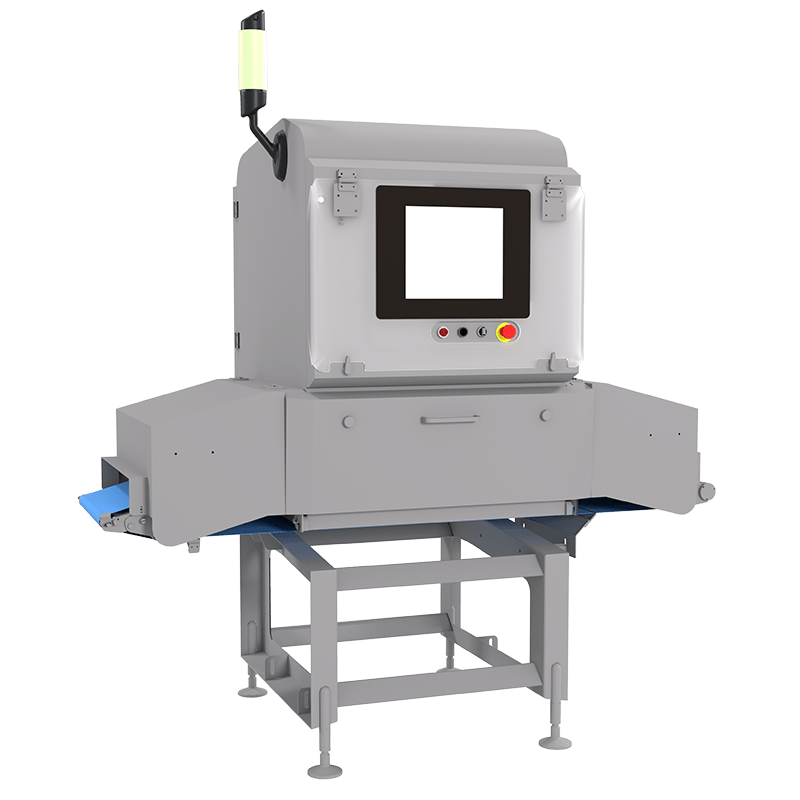Engineering Residual Bone Detection: From X-Ray Physics to Line Integration
1. The Mechanical Origin of Bone Fragments
Automated deboning uses high-RPM blades and pressure plates.
· Chicken: Hollow bones → brittle fracture → sharp, hollow splinters
· Red Meat: Dense bones → shear fracture → fine chips and dust
These fragments are not removed by vibration screens or air knives—they require in-line imaging.
2. Why Standard X-Ray Fails: A Systems View
Parameter | Traditional X-Ray | Failure Mode |
Resolution | 0.4–0.8 mm/pixel | Misses <1 mm fragments |
Energy | Single (e.g., 60 kV) | No material separation |
Detector | CsI scintillator, low density | Poor low-energy capture |
Processing | Rule-based thresholding | Confused by shadows |
Root Cause Summary:
1. Spatial blur → small bones lost
2. Spectral overlap → meat/bone indistinguishable
3. Signal starvation → thick meat absorbs photons
3. Red Meat: The Attenuation Wall
X-ray intensity follows Beer-Lambert Law: I = I₀ × e^(−μ×t) Where:
· μ = attenuation coefficient
· t = thickness
For beef at 100 mm:
· ~90% of photons absorbed
· Deep bones receive <10% original signal → no contrast
Stacking doubles the problem. Uneven surfaces create local μ variations → pseudo-contours in image.
4. The Triple-Integration Detection Stack
Layer | Function | Engineering Spec |
Dual-Energy Source | High (120 kV) + Low (60 kV) beams | Alternating or simultaneous pulse |
UHD Line-Scan Detector | 0.05–0.1 mm pitch, high-DQE | >10,000 pixels across 600 mm belt |
AI Inference Engine | Real-time CNN (e.g., ResNet-50) | 30–60 ms latency, GPU/FPGA |
5. Dual-Energy Signal Processing (Step-by-Step)
1. Acquire High-Energy Image (H) 2. Acquire Low-Energy Image (L) 3. Compute Logarithmic Ratio: R = log(H) − log(L) 4. Bone → High R value (due to low-energy preference) 5. Output: Material-Classified Image
Advantage: Ratio image is thickness-independent.
6. Integration Blueprint for Engineers
Component | Requirement | Integration Note |
X-Ray Generator | Dual kV switching | Sync with detector trigger |
Conveyor | 0.1–0.6 m/s | Encoder pulse for line-scan sync |
Cooling | 30–40°C ambient | Water or forced air |
Data Output | OPC-UA / MQTT | PLC or SCADA link |
Reject Mechanism | Air jet or pusher | <50 ms response |
Throughput: Up to 600 pieces/min at 0.1 m/s and 10 cm spacing.
Conclusion Residual bone detection is an engineering challenge, not a quality afterthought. Legacy single-energy X-ray is obsolete for sub-mm hazards. The path forward: dual-energy sources, UHD detectors, and embedded AI. For plant engineers, the task is integration—syncing physics with line speed, cooling with uptime, and data with traceability.
The system is only as strong as its weakest calibration.


Related Articles
-
 Nov-07-2025
Nov-07-2025Why Residual Bones Remain a Top Food Safety Risk in Modern Processing
Why Residual Bones Remain a Top Food Safety Risk in Modern Processinglearn more -
 Nov-07-2025
Nov-07-2025X-Ray Technology: Safeguarding Poultry Product Safety
Poultry processors face increasing demands for food safety and quality. Bone fragments or foreign materials such as metal, glass, or ceramic can appear in chicken breasts, thighs, whole chickens, and processed products like nuggets or patties. Raymantech X-Ray Inspection Systems make this process safer and smarter by detecting even tiny or low-density contaminants that traditional methods often miss.learn more -
 Nov-07-2025
Nov-07-2025How Safe is X-ray Inspection of Food?
Consumers and manufacturers alike worry about contamination in food – broken glass, metal fragments, plastic or stone – entering a product and harming someone or prompting a recall. X-ray inspection systems have become a key solution: conveyors carrying packaged or unpackaged food pass through a shielded X-ray machine that “sees” inside each item. This technology complements traditional metal detectors and manual checks to catch a wider range of hazards. Importantly, extensive research and industry experience show that food X-ray inspection is extremely safe. Nearly everything we eat – from spices to snacks – is X-rayed at some point during production, and regulatory bodies (like the FDA) report “no known adverse effects” from the low-dose X-ray scans used in food plants.learn more

Quick Links
Contact
Tel: 717-490-1513
Add: 1050 Kreider Drive -
Suite 500, Middletown,
PA 17057







